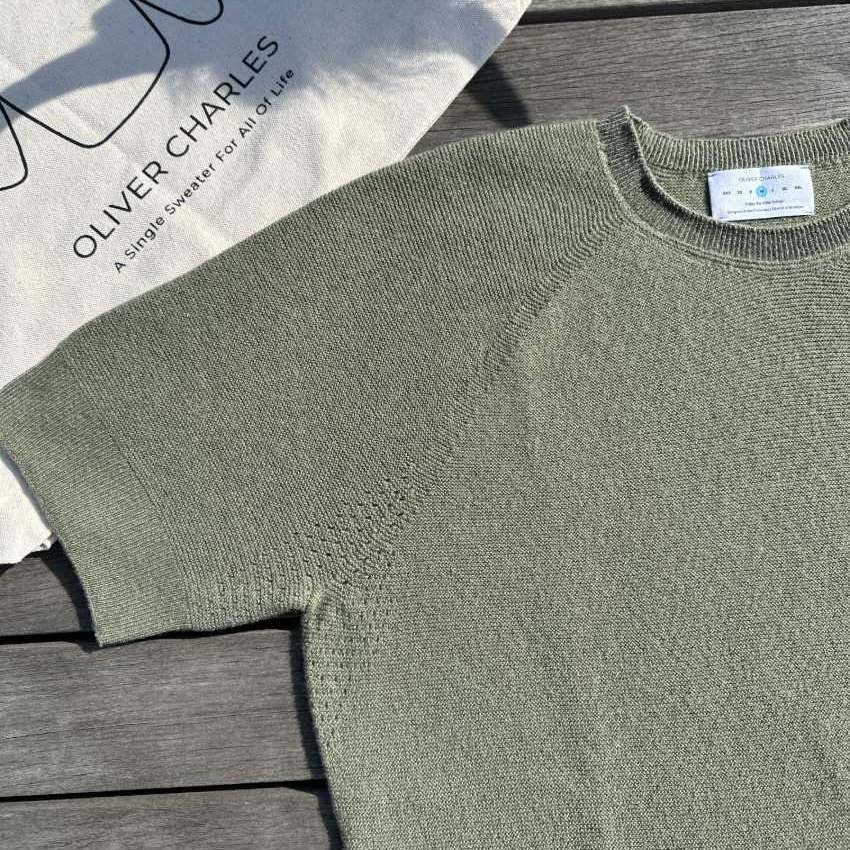Sustainable Wool Sweaters And The Economic Choices We Make
It's past time to kill the fast fashion haul.
March 6, 2025
By Caitlin Heflin
Less Is More: When Curating Your Closet Simplifies Life
Introducing the third blog in my 3-part blog series that navigates how to honor your style and taste while consuming less fast fashion.
In this blog, I’ll take a wider look at how buying less fast fashion and curating your closet can benefit your household economy and the overall environment.
----------
At this point, it's a well-known fact that fast fashion is environmentally harmful.
But just because we know something to be true doesn’t always mean we act on it.
Fast fashion is easy and cheap, two things that make it an incredibly tempting buy when compared to shopping from more sustainable slow fashion brands.
Additionally, with the advent of social media and online shopping, fashion cycles have accelerated. Gone are the days of seasonal changes in retail store inventory. Nowadays, big fast fashion retailers are refreshing their merchandise on a weekly or even daily basis.
This steady increase in demand for new articles of trendy clothing is incredibly detrimental to the planet, but it is also harmful to consumers.
The quality of fast fashion clothing is abysmal, and the constant drive for more, more, more is a drain on buyers’ bank accounts.
That said, as consumers, we have more control than we realize. We can vote with our wallets and refuse to bankroll exploitative businesses that only serve their bottom line. Although it might be hard to do, I think it’s past time to break up with fast fashion.

We’re Drowning In Fabric: The Environmental Impact
According to the United Nations Environment Programme (UNEP), people are purchasing more clothing and wearing them for less time than at any other point in history.
Trends shift with the winds, and items rapidly gain an intense amount of popularity before disappearing from the public consciousness as swiftly as they emerge.
Take the "Strawberry Dress" by the designer Lirika Matoshi. This beautiful piece, initially launched in 2019, became a viral sensation in 2020, spawning numerous fast fashion knockoffs. Though the original costs nearly $500, its price reflects sustainable fabric sourcing and fair wages.
Matoshi, from what I can see online, is an ethical retailer, so it is disappointing when her designs are fully ripped off and re-sold for cheap by a business far less concerned with the well-being of its employees and our planet.
Brief tangent aside, when was the last time you saw the Strawberry Dress on your social media feed? It isn’t any less beautiful, well-made, or fashionable than it was in 2020, right? But now, it is nowhere to be found, because it had its moment, and no one cares about being seen in it anymore. So where did all those knock-off Strawberry Dresses go? I think we already know the answer.
An analysis conducted by Business Insider found that 85% of textiles in the United States find their way to a landfill or incinerator every year. Fashion production accounts for 10% of carbon emissions.
For context, that is about as much as the emissions for the entire European Union. Fashion is second only to agriculture when it comes to water consumption.
Roughly 2,000 gallons of water are consumed while producing one single pair of jeans. One. Single. Pair. On top of this, the byproducts from textile dyeing end up in streams and rivers, making the fashion industry the second-largest polluter of Earth’s waterways.
Additionally, these brands typically eschew natural fibers in favor of synthetic ones like acrylic, nylon, or polyester. Manufacturing these artificial fibers requires an obscene amount of fossil fuels, mainly oil, and spews out harmful chemicals like hydrogen chloride.
Sadly, the negative impact of synthetic fibers does not end with their creation. Not only do these fabrics take hundreds of years to break down, but they also shed microplastics when washed, sending them straight into our planet’s water system.
All of this is not even considering all the environmental harm that endless shipping all over the world can beget.
Aside from the harm to the planet, fast fashion is harmful to humanity specifically, with many companies exploiting labor in developing or economically struggling nations.
In 2018, the United States Department of Labor found evidence of both forced and child labor within the fashion industries in China, India, Indonesia, Vietnam, and other nations; countries where fast fashion giants often like to set up shop.
As Rashmila Maiti poignantly noted in her piece, Fast Fashion and Its Environmental Impact, “Rapid production means that sales and profits supersede human welfare.”

We’re Drowning In Debt: The Economic Impact
While the environmental and moral impact of fast fashion is devastating, the social costs for consumers are equally alarming. As mentioned above, most people are not fiscally prepared to drop almost $500 on a dress with a limited range of use.
The average American spends about $120 on clothing per month, so, understandably, people would look for a more cost-effective option. I, too, feel the pinch when I’m looking for a new piece of clothing and I see something from a fast fashion retailer that costs $14. It is difficult to pay more when someone is offering a similar product for less.
Even so, here is where we have to be conscious consumers: it is not sufficient to go with the lowest price. Why does it only cost $14? Is something wrong with it? Are the materials cheap? Will it fall apart after one wear and a wash? And lastly, what was the laborer that made the garment paid?
After all, this business must feel like it can net a profit at such a small price point. Imagine buying a trendy dress for $14, only to see it fall apart after one wash. You’re left with a useless garment and a sense of regret, all while contributing to environmental degradation.
Our actions have consequences, and while it might feel nice to have that cheaply made dress when it first arrives in the mail, the reality is that it will either not stand up to time and use it, or you will never wear it again because the “trend” is over. So, because it was low-priced you won’t feel as guilty getting rid of it, and it will get donated or thrown away and become a part of that 85% of textiles in America’s landfills. The cycle repeats ad nauseam.
However, if you’re consistently buying haul after haul of fast fashion, in the name of a bargain, are you really saving any money? Sure, you can get more clothing than if you bought one or two pieces from a sustainable retailer, but why do we believe more is superior? As a nation, over a quarter of us have under $1,000 in savings, and this figure is larger for Millennial and Gen Z Americans.
We’re saddled with record amounts of debt, and the cost of living is steadily outpacing our wages. It is natural to look for a way to ease the burden, but the choice to continually fuel fast fashion comes with too many ramifications to be a viable one.

Can Sustainable Materials Throw Us A Lifeline?
Now arguably, you can’t just uproot an entire system without creating mayhem. Fast fashion is an industry worth trillions of dollars and the source of income for many, many people.
It has also democratized fashion–anyone can sport a lookalike or knock-off of the latest celebrity gown without going broke to pay for it.
I would argue that having an affordable option for clothing purchases is also a net positive for many who struggle with financial hardships.
It will take time and a fair degree of social re-wiring for the predatory and environmentally harmful aspects of fast fashion to sink to the grave.
Some behaviors have to be altered. Rather than purchasing everything that fits the latest microtrend, why not comb your closet to see if what you have can be styled in a way that mimics it?
If not, rather than shopping for new clothing, see if what you want is available in your friend’s wardrobe, at a second-hand retailer, or within a buy-nothing group.
By making the fashion industry less linear and more circular, consumers can make an impact, even if buying new clothing here and there is unavoidable.
Still, as I said before, we vote with our dollars. While it may not be as momentarily cathartic as buying cheap clothing from fast fashion, that money can be put toward sustainable, well-made clothing.
Yes, one item from these brands might cost as much as 17 items from fast fashion, and that upfront investment can seem daunting.
Yet, as your well-made garments stand the test of time, wash after wash, long after their fast fashion peers have gone the way of the dodo, you will see your investment pay off. Look for timelessness, look for quality, look for sustainability.
Brands like Oliver Charles are creating sturdy, ethically sound, and fashionable garments that are useful across a range of styles and clothing needs.
Using natural fibers like yak wool and SeaCell, Oliver Charles is demonstrably transparent in its business and sourcing practices, and eager to educate the consumer.
By creating comfortable clothing that can be worn over and over again, requires less washing, and meets the needs of a varied buyer base, Oliver Charles is actively working to combat the negative impact of the fast fashion industry.
Even though the rush of a shopping spree can be heady, and you likely won’t get the same flood of endorphins while practicing conscious consumerism, you will get the good feeling of doing something in a world that seems hopeless.
So much is out of our control these days, but there might be more power within our reach if we could only stand up and grasp it.
If you believe that every good wardrobe starts with owning less and owning better, consider buying yourself an OLIVER CHARLES sweater.
Shop NowSustainable Sweaters For Self-Care
How investing in a sustainable wardrobe benefits our mental health.
Read more7 Day Challenge: Yak Wool Is Perfect For Winter And Spring
Testing the Oliver Charles All Season Boat Neck in classic Wyoming winter activities.
Read moreSeasonal Minimalist Wardrobe Is Out
All you need is one Oliver Charles sweater for all seasons.
Read moreThis Yak Wool Sweater Elevated My Wedding Weekend Wardrobe
How I stayed comfortable and stylish in a sweater during my wedding festivities.
Read more



